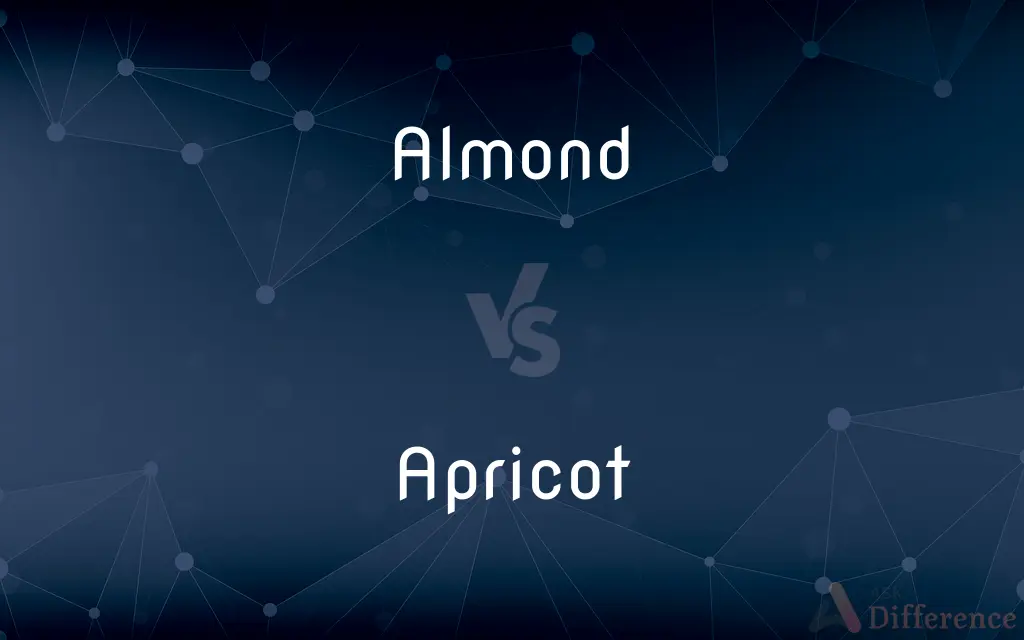Almond vs. Apricot — What's the Difference?
By Maham Liaqat & Fiza Rafique — Updated on March 28, 2024
Almonds are edible seeds of the Prunus dulcis tree, known for their health benefits, while apricots are sweet, orange fruits from the Prunus armeniaca tree.

Difference Between Almond and Apricot
Table of Contents
ADVERTISEMENT
Key Differences
Almonds and apricots both belong to the Prunus genus, making them closely related, but they serve very different culinary and nutritional roles. Almonds, technically the seeds of the almond fruit, are highly regarded for their nutritional content, including healthy fats, protein, and fiber. They are consumed raw, roasted, or as almond milk, butter, and flour. Apricots, on the other hand, are sweet fruits enjoyed either fresh or dried and are valued for their vitamins, especially vitamin A and C, and fiber content.
While almonds are primarily grown for their seeds, the apricot tree is cultivated for its fruit. Almond trees bloom with white to pale pink flowers, whereas apricot trees feature pink to white flowers. The climatic and soil requirements for growing almonds and apricots are similar, but their cultivation practices and harvesting times may vary, reflecting the different parts of the plant that are harvested and how they are used.
Almonds have a wide range of uses in the kitchen, from being a snack on their own to being ingredients in sweet and savory dishes. They're also used in non-dairy products. Apricots are versatile in culinary uses as well; they can be eaten fresh, used in desserts like pies and jams, or added to savory dishes for a sweet contrast. Dried apricots are a popular snack and ingredient in various recipes.
Nutritionally, almonds are known for their high monounsaturated fat content, which is beneficial for heart health, and their significant levels of vitamin E, magnesium, and potassium. Apricots, while lower in overall calories, provide a good source of dietary fiber, vitamin A, and potassium. They also have a higher water content, making them a hydrating snack during the warmer months.
In terms of cultural significance, almonds have a deep historical presence in many cuisines and traditions around the world, symbolizing various cultural beliefs and practices. Apricots also hold cultural importance in many regions, often associated with education and medicine in ancient times, and continue to be celebrated in festivals and culinary traditions globally.
ADVERTISEMENT
Comparison Chart
Type
Seed of the Prunus dulcis tree.
Fruit of the Prunus armeniaca tree.
Nutritional Highlights
High in healthy fats, protein, vitamin E.
High in vitamin A, C, and dietary fiber.
Uses
Snacks, almond milk, flour, and butter.
Fresh, dried fruit, jams, and savory dishes.
Flower Color
White to pale pink.
Pink to white.
Cultural Significance
Symbolizes various beliefs worldwide.
Associated with education and medicine.
Texture
Crunchy and nutty.
Soft, sweet, and slightly tart.
Water Content
Low.
High.
Compare with Definitions
Almond
Edible seed of the almond tree.
Almonds are a nutritious snack, rich in healthy fats.
Apricot
Sweet, orange fruit of the apricot tree.
Fresh apricots are a delicious source of vitamins A and C.
Almond
Cultivated in Mediterranean climates.
California is a leading producer of almonds globally.
Apricot
Features in various culinary dishes.
Apricot jam is a common spread for toast and pastries.
Almond
Used in a variety of dietary products.
Almond milk is a popular lactose-free alternative to dairy milk.
Apricot
Lower in calories and rich in fiber.
Apricots are a healthy option for a diet rich in fruits.
Almond
Contains significant vitamin E and magnesium.
Eating almonds can contribute to heart health and bone strength.
Apricot
Grows in similar climates to almonds.
Turkey is known for its high-quality apricot production.
Almond
Often found in desserts and savory dishes.
Ground almonds are used to make marzipan and almond butter.
Apricot
Can be consumed fresh or dried.
Dried apricots are a convenient, nutritious snack.
Almond
The almond (Prunus dulcis, syn. Prunus amygdalus) is a species of tree native to Iran and surrounding countries but widely cultivated elsewhere.
Apricot
An apricot (US: (listen), UK: (listen)) is a fruit, or the tree that bears the fruit, of several species in the genus Prunus (stone fruits). Usually, an apricot is from the species P. armeniaca, but the fruits of the other species in Prunus sect.
Almond
A deciduous tree (Prunus dulcis) in the rose family, native to Asia and northern Africa and having alternate, simple leaves, pink flowers, and leathery fruits.
Apricot
A deciduous tree (Prunus armeniaca) native to Asia, having alternate leaves and clusters of usually white flowers.
Almond
The ellipsoidal kernel of this tree, either eaten as a nut or used for extraction of an oil for flavoring.
Apricot
The edible orange-yellow fruit of this tree.
Almond
Any of several other plants, such as the Indian almond, especially those with fruits or seeds suggestive of the almond.
Apricot
A moderate, light, or strong orange to strong orange-yellow.
Almond
Something having the oval form of an almond.
Apricot
A round sweet and juicy stone fruit, resembling peach or plum in taste, with a yellow-orange flesh, lightly fuzzy skin and a large seed inside.
Pickled apricots
Almond
A pale tan.
Apricot
The apricot tree, Prunus armeniaca
Almond
(countable) A certain tree nut.
Apricot
(color) A pale yellow-orange colour, like that of an apricot fruit.
Almond
(countable) A small deciduous tree in family Rosaceae, Prunus amygdalus, that produces predominantly sweet almonds.
Apricot
A dog with an orange-coloured coat.
Almond
Other plants that produce almond-like nuts:
Apricot
A testicle.
Almond
Prunus dulcis var. amara, bitter almond, that only produces bitter fruits
Apricot
Of a pale yellowish-orange colour, like that of an apricot.
Almond
Prunus japonica, flowering almond, an ornamental shrub in family Rosaceae
Apricot
A fruit allied to the plum, of an orange color, oval shape, and delicious taste; also, the tree (Prunus Armeniaca of Linnæus) which bears this fruit. By cultivation it has been introduced throughout the temperate zone.
Almond
Prunus andersonii, desert almond, a North American shrub in family Rosaceae
Apricot
Asian tree having clusters of usually white blossoms and edible fruit resembling the peach
Almond
Prunus fasciculata, desert range almond or wild almond, North American shrub in family Rosaceae
Apricot
Downy yellow to rosy-colored fruit resembling a small peach
Almond
Terminalia catappa, Indian almond or tropical almond, in family Combretaceae
Apricot
A shade of pink tinged with yellow
Almond
Brabejum stellatifolium or bitter almond, in family Proteaceae
Almond
(uncountable) The colour of the kernel of an almond without its shell and thin seed coat, a creamy off-white colour.
Almond
(uncountable) The color of an almond still covered by its skin, a shade of brown.
Almond
(uncountable) Flavor or other characteristics of almond.
I can't eat it if it has too much almond in it.
Almond
Anything shaped like an almond; specifically, a tonsil.
Almond
Brownish, resembling the colour of an almond nut.
Almond
The fruit of the almond tree.
Almond
The tree that bears the fruit; almond tree.
Almond
Anything shaped like an almond.
Almond
Small bushy deciduous tree native to Asia and North Africa having pretty pink blossoms and highly prized edible nuts enclosed in a hard green hull; cultivated in southern Australia and California
Almond
Oval-shaped edible seed of the almond tree
Common Curiosities
How are almonds harvested compared to apricots?
Almonds are harvested by shaking the tree to release the nuts, while apricots are often picked by hand to prevent bruising.
Can you eat the seed inside an apricot?
Apricot seeds can be eaten and are known for their bitter taste; however, they contain amygdalin, which can be toxic in large quantities.
Which is healthier, almonds or apricots?
Both are healthy; almonds are excellent for healthy fats and protein, while apricots are rich in vitamins and fiber. The choice depends on nutritional needs.
Are almonds and apricots related?
Yes, both almonds and apricots belong to the Prunus genus, making them closely related species.
What is the significance of almonds in cultural traditions?
Almonds have various symbolic meanings, including purity and good fortune, and are used in wedding and holiday traditions in many cultures.
Can I substitute almond products for apricot products in recipes?
Substitution depends on the recipe. Almond flour can replace apricot kernels in some recipes, but fresh apricots and almond products serve different culinary purposes.
How do the climates for growing almonds and apricots compare?
Both require similar Mediterranean climates with warm, dry summers and mild winters, though specific soil and water requirements may vary.
What are the main differences in nutritional content between almonds and apricots?
Almonds are high in protein and healthy fats, while apricots offer a good source of vitamins A and C and are lower in calories.
Do almonds and apricots bloom at the same time?
Their bloom times can overlap in early spring, but exact timing depends on the variety and climate.
Are there any dishes that feature both almonds and apricots?
Yes, there are many dishes, especially in Mediterranean and Middle Eastern cuisines, that use both almonds and apricots for a blend of textures and flavors.
Share Your Discovery

Previous Comparison
Website vs. Platform
Next Comparison
Tease vs. BaitAuthor Spotlight
Written by
Maham LiaqatCo-written by
Fiza RafiqueFiza Rafique is a skilled content writer at AskDifference.com, where she meticulously refines and enhances written pieces. Drawing from her vast editorial expertise, Fiza ensures clarity, accuracy, and precision in every article. Passionate about language, she continually seeks to elevate the quality of content for readers worldwide.














































